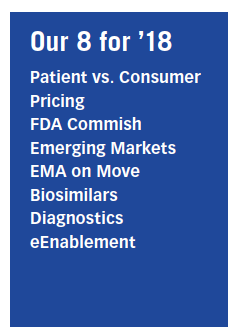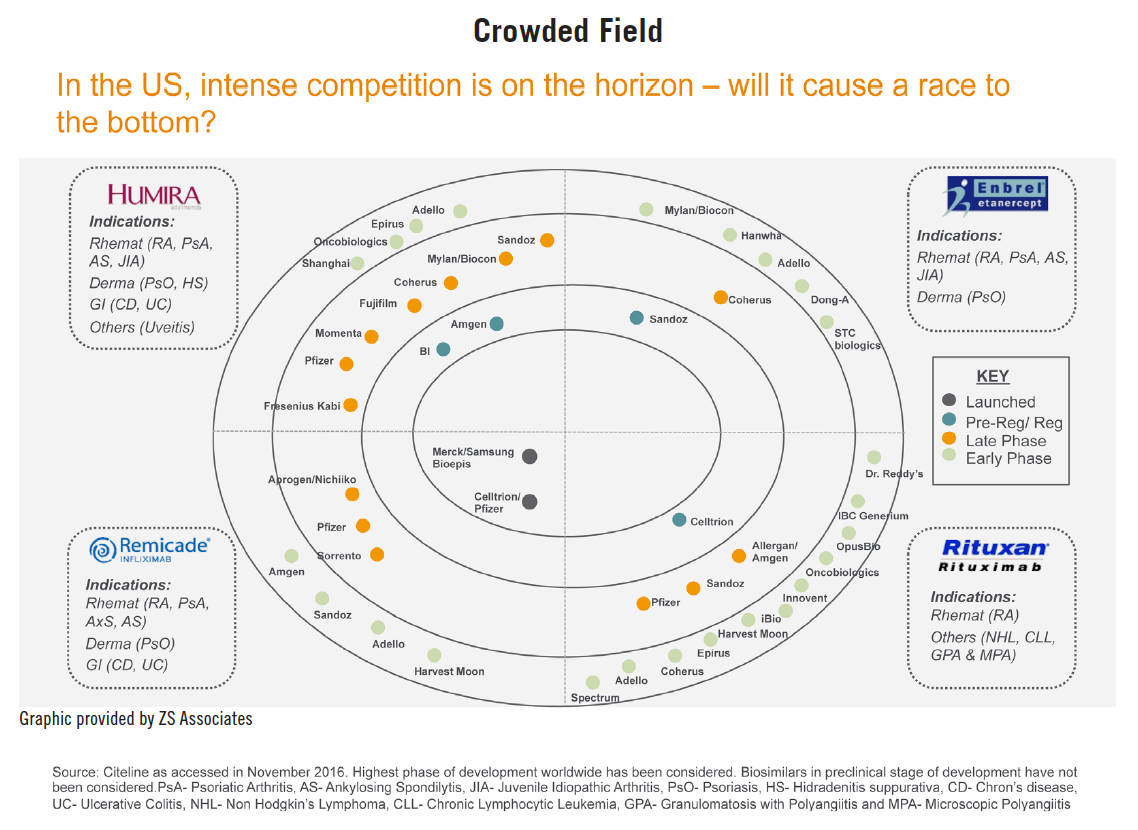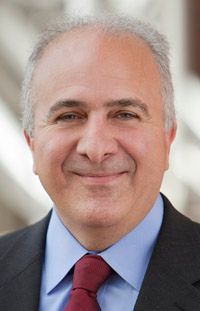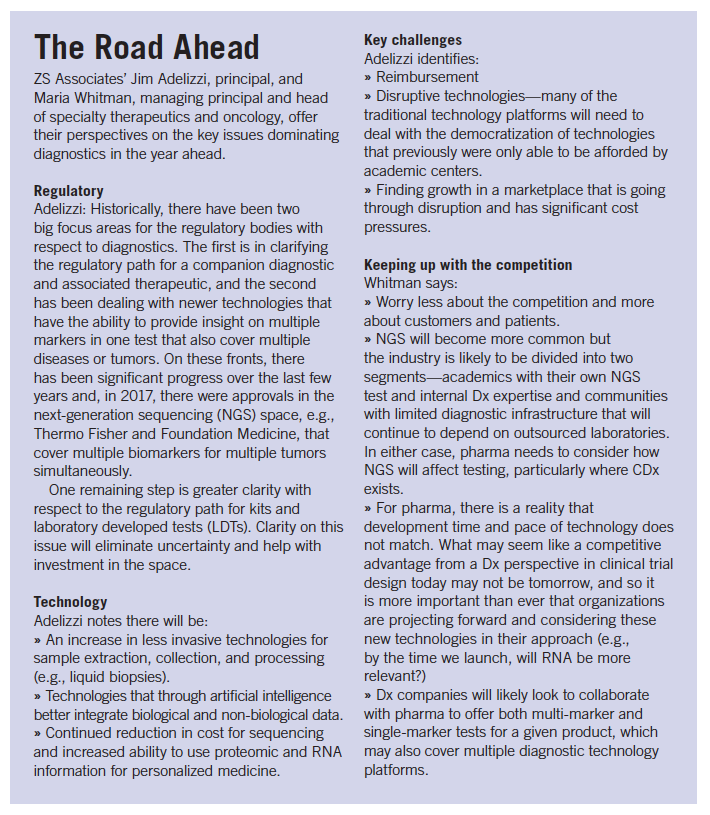Changing Skies: Pharm Exec’s 2018 Industry Forecast
Pharmaceutical Executive
In our annual temperature check on the life sciences sector and its outlook for the months ahead, we explore eight trends that will shape the biopharma industry landscape in 2018.
8 Trends to Watch: In its annual industry outlook report, Pharm Exec examines eight trends that will shape the biopharma industry landscape in 2018
In this year’s Pharm Exec Industry Forecast, our annual temperature check on the life sciences sector and its outlook for the months and seasons ahead, we decided to try a slightly different approach. We again are highlighting what we feel are, globally, the most important industry-shaping trends, but have singled out eight specific pulse-setters, in particular, for examination-by our staff and correspondents and with insights from

PharmExec Editorial Advisory Board (EAB) members and other experts. Call it our “8 for ’18,” if you will. We wanted to make sure the topics and events we explored were diverse-covering areas that impact patients, business, the regulatory climate, and science.
After all, as most would attest, the inevitable change and sway that grips all major industries is afoot. Just look at the flurry of activity at the end of 2017. In the US, major tax reform legislation was passed under the wire. The significantly lowered corporate tax rate and other changes could boost pharma investment and stop the shift of profits by US companies to affiliates in lower-tax countries. At the same time, however, the new law cuts tax benefits for rare disease R&D. In Europe, Amsterdam won the coveted prize as the new home base for the European Medicines Agency (EMA) come March 30, 2019, when Brexit- loose ends and all-is official.
Add to the mix a potential upsurge in M&As, the critical testing period ahead for CAR-T and other novel therapies on the commercial stage, and the pricing debate that rages on (amid new findings that healthcare spending on prescription drugs has almost doubled since the 1990s), and it’s clear 2018 is shaping up as must-see viewing.
More Coverage:
The ‘Patient’ vs. ‘Consumer’ Conundrum
Should engagement models consider label change?
During the recent Financial Times Digital Health Summit presented by FT Live, one of the speakers asked the audience to do this:
“Raise your hand if you consider yourself a patient.”
About five hands went up.
Then, the speaker said this:
“Raise your hand if you consider yourself a consumer.”
All hundred or so people in the room raised their hand.
The point the speaker was trying to get across was multileveled, but in general the exercise was to show that unless someone has a specific condition they are being treated for, a majority of people consider themselves a consumer, not a patient. And if pharmaceutical and healthcare companies want to stay ahead of the Apples and Amazons of the world who are threatening to disrupt the industry, they need to start viewing those who use, or “consume,” their products as consumers, and not just as patients.
It would signal a fundamental and psychological change in most ways a business functions. In the pharma space, it wouldn’t necessarily impact the science behind a drug, but, according to experts, could potentially change the way other aspects of business are done.
Joshua Newman, chief medical officer at Salesforce, explained how consumer-centric companies think about things differently than pure pharma does.
“These organizations appeal to us, they are available to us, and they respond to us,” he said at the Summit last fall, adding that there was a time when it was just about the product or just about the customer service. “Now, it’s the entire journey,” he said.
Using Amazon, Google, and Uber as examples, Newman explained that following this model wasn’t the way these companies started out, but they learned to evolve over time.
“Things have changed and the reason is not because we (consumers) have demanded it, but because they were sensitive to it,” said Newman. “They were sensitive to what we needed; they realized to compete, they had to give us a beautiful, easy, and frictionless experience. They take care of us not only when we are buying

something from them, but from the time before on past the time we have used their product. And they keep reminding us they are around anytime we want to use their products.”
In the pharma and healthcare space, some say this is the missing piece of the patient care puzzle-and as patient centricity continues to be a buzzword, and companies dig deeper into what that actually looks like, the consumer aspect is going to come up more and more.
“Very few people complain about their drugs, very few people complain about their devices that have been installed, the surgeries, or the actual mechanics of clinical care; but everyone complains about the logistics,” Newman pointed out. “Everyone has a story about the administration, everyone has anxieties, everyone has questions that are unanswered … they don’t know what to do, and that’s what I think the biggest gap is, and it’s also the biggest opportunity.”
To think that a patient who is “consuming” drug therapies (e.g., chemotherapy) could one day pick up their mobile phone, open their apps, hop on Amazon, order it, and have it delivered right to their door is far-fetched. But those who believe the pharma industry needs to start thinking of its patients also as consumers will argue that scenario has to be part of the thought process in order to stay relevant, especially as non-traditional companies who excel at the customer experience enter the space.
The driving force amplifying this as an industry trend is technology. As technology evolves in other industries, making them more consumer-friendly, patients are going to expect the same level of customer convenience they are getting from other businesses touching their lives.
“How do we establish technological platforms, data connections that lower the activation energy and difficulties that people have right now worrying, learning, and engaging in their health and how this technology more effectively empowers consumers to make decisions about their health?” said Lloyd Minor, dean of Stanford School of Medicine.
But not everyone is behind this shift in wording.
Michael Mittelman, vice president, strategic partnerships and patient advocacy, at the American Living Organ Donor Fund, and a three-time kidney transplant recipient with other chronic conditions, challenges the idea of calling patients consumers.
“Patients referred to consumers bothers me,” he said. “Patient-centered programs should be designed for patients. Patients are not consumers.”
Although companies like Google or Amazon might be good at what they do when delivering a consumer experience, it doesn’t necessarily mean they will be good at translating those skills to pharma, citing Google Health and HealthVault as poor performers.
One thing is certain-the conversation about patients and consumers will continue to gain attention as more non-traditional companies who are consumer-focused enter, or threaten to enter, the pharma and healthcare space.
-Michelle Maskaly
Pricing Fix Elusive
States may take full control
Pricing in the US as a trend for pharma is not new, it just keeps twisting into different forms. Last year, of course, the talk of pricing swirled around President Trump’s negative comments around prescription prices. With a lack of any movement on prices on the federal level, individual states took hold of the reins by instituting their own laws around pricing. Will 2018 be the year that states take full control of the drug pricing issue in the US? At least 176 bills on pharma pricing and payment were introduced in 2017 in 36 states,
according to the National Conference of State Legislatures.

In early October, California Gov. Jerry Brown signed a law requiring pharma companies to notify the state and health insurers anytime they plan to raise the price of a medication by 16% or more over two years. And companies will have to provide justification for the increase. Health insurers also were instructed to report what percentage of premium increases are due to drug prices.
A new Maryland law takes aims at price hikes on generics of older off-patent drugs after some companies took massive increases on generic drugs not facing competition from other distributors.
In Ohio, a referendum that would have leveled drug prices was defeated and a report said the proposal’s complexity may have been its undoing. It would have prohibited state programs, such as Medicaid and state employee health plans, from paying more than what the Veterans Health Administration pays for a medication. But a nonpartisan office concluded it was unclear how much money the proposed change would save, if any.
And therein lies the rub: “unclear how much money the proposed change would save, if any.”
Ed Schoonveld, head of the value and access group for ZS Associates, told Pharm Exec, “There is a lot of frustration regarding drug pricing in the US, and much of it is political. Absent of an easy fix, politicians say ‘Well, we have to do something’ and this is where we are.” He added, “It’s hard to make sense of list prices. The real concern is where are the rebates going? That’s what we should be looking at.”
Schoonveld also emphasized that government and payers need to be careful with what they are requiring. For example, what if a company wasn’t planning on raising its prices anywhere close to 16% over two years. Now, increasing within the guidelines looks like a great option since no penalties will be enforced.
And in the case of generics, there again needs to be a balanced discussion. At a World Health Organization (WHO) fair pricing meeting last year, Schoonveld said, “There was a concern over the supply of generics. In effect, they were saying don’t make your tender policies so aggressive that companies will exit, leaving you with only few alternatives.”
Another trend in pricing is the shift toward value-based or outcomes-based contracting-which is a much larger topic that will be discussed throughout the year. Suffice to say that Schoonveld believes that there needs to be a focus on long-term outcomes and how to fund those. “Many innovations are coming to the market and affordability is becoming a real issue,” he says. “We need to have a good conversation about the desired outcomes of new treatments and how we pay for it. It’s become a societal issue.”
While Schoonveld doesn’t suspect the trend with states passing pricing and payment laws will cool off, it also will not resolve anything, he believes. “This is a broader healthcare funding issue. And pharma needs to be a part of the discussion and engage in the dialogue with the insurance industry, medical community, and government.”
-Lisa Henderson
FDA Proving Grounds
The agency’s man with a plan
“2018 is his year to prove.”
“His leadership and vision at FDA is clearly aggressive and ambitious.”
“[He is] very proactive, a 21st century thinker.”
“[He] believes in adaptive trial design, improving functioning of FDA.”
“Will this be the year he makes an impact?”
These were the comments that Pharm Exec’s Editorial Advisory Board made regarding FDA Commissioner Scott Gottlieb when discussing this year’s industry forecast. Our Washington Correspondent, Jill Wechsler, has covered Gottlieb’s appointment and activities since his official nomination in late March. She reported that on the day Gottlieb was confirmed in May, the FDA Science Board approved a detailed work plan for allotting
Scott Gottlieb

$500 million over nine years provided by the 21st Century Cures Act.
Some of the Cures initiatives include qualifying more biomarkers and other drug development tools; modernizing clinical trial design; using more real-world evidence (RWE) to approve new indications and post-marketing studies; expanding the role of patients in assessing new drug risks; and promoting more coordination among FDA centers, particularly for combination products. FDA, under Gottlieb, has already checked off some of those boxes, and made good on his own promises, signals that Gottlieb is aggressively moving the FDA ball forward.
On June 29, the commissioner told the Senate Appropriations subcommittee that FDA’s new Orphan Drug Modernization Plan would eliminate a backlog of 200 pending orphan designation requests by mid-September and establish procedures for vetting such requests within 90 days in the future. The backlog for requests older than 120 days was completed on August 28.
In the area of biomarkers and diagnostics, November saw the FDA approval of FoundationOne CDx (F1CDx), the first breakthrough-designated, next-generation sequencing (NGS)-based in vitro diagnostic (IVD). The test can detect genetic mutations in 324 genes and two genomic signatures in any solid tumor type. At the same time, the Centers for Medicare and Medicaid (CMS) proposed coverage of F1CDx. The test is the second IVD to be approved and covered after overlapping review by FDA and CMS under the parallel review program, which facilitates earlier access to innovative medical technologies for Medicare beneficiaries.
In recognition of the importance of postmarketing studies, FDA, in mid-December, reported for its fiscal year 2016 that the number of open postmarketing requirements (PMRs) and postmarketing commitment (PMCs) had decreased from 1,636 to 143. Dr. Peter Stein, deputy director, Office of New Drugs, at the Center for Drug Evaluation and Research (CDER), noted that FDA is committed to making sure industry fulfills its PMRs and PMCs and that the postmarketing studies are transparent to the public. Gottlieb, after the announcement, took to Twitter at @SGottliebFDA: “Post-approval studies enhance patient safety & public health, can lead to safety labeling changes, support expanded use of drug, alleviate risk concerns.”
Other comments that Gottlieb has made could come to fruition in 2018 around RWE, biosimilars, and the opioid crisis. Gottlieb has said that clinical trials may not always require randomization, and that faster studies don’t necessarily compromise on safety or undermine the FDA gold standard for assuring medical product efficacy. He has said that RWE won’t replace traditional clinical trial data in many cases; however, he sees opportunity in the pre- and postmarket context to use this data to modernize development, and that FDA will collaborate with all stakeholders to achieve a “more appropriate adoption of RWE as part of the entire life cycle of medical products.”
As noted elsewhere in our Forecast coverage, the topic of biosimilars in the US, in particular, is in a holding position. During Gottlieb’s confirmation hearing, he specifically said, “I think Congress didn’t envision with Hatch-Waxman that certain drugs would have monopolies in perpetuity, long after their intellectual property has expired, but for the inability of FDA to have a scientific process that can prove interchangeability for those drugs. I think this is an area where we can make a lot of progress. We might need to come back to Congress to talk to them about what additional steps we need to take, but I think there are things FDA could contemplate administratively. This is an area I want to work on. These are literally billions of dollars worth of drugs each year that are sold as branded drugs at high prices, but should be subject to generic competition.” However, as noted, much of the biosimilar activity is tied up in the US legal system.
All in all, Gottlieb has started strong and there is no indication he will let up in 2018. In fact, his mid-December blog foreshadowed upcoming activity. Besides his apparent commitment, Gottlieb’s Twitter game is spot on.
-Lisa Henderson
Public Health, Private Care
Emerging market perspectives
Colombia
The Latin American markets continued to fluctuate in 2017. Recession and public health spending cuts further compromised Brazil’s appeal as an attractive region for multinational investors and widened the gulf between the country and its leading BRIC counterpart, China. Venezuela spiraled further into economic collapse, the country’s gross domestic product (GDP) shrinking by 19% as the catastrophic effects of steeply falling oil prices and a crumbling political system took hold. The weight of Latin American expectation, then, has since shifted to Colombia, described by Pharm Exec’s October 2017 Country Report as “a bastion of peace, stability, and resilience,” with GDP growth rates of around 2% for 2017 and “thriving domestic consumption set to propel the value of the local pharma market from $5 billion in 2015 to $7.1 billion by 2020.”
Colombia boasts 108 of the 400 free-trade zones in Latin America, with Focus Reports observing that multinationals “tend to be thrilled by the ‘level playing field’ on offer and the sheer openness of the market.” Colombia has implemented trade agreements with a host of countries, including the US, the EU nations, Canada, Japan, and South Korea, while expanding its trade relations with Latin American neighbors such as Mexico. Similarly, Colombia’s medical device industry is encouraging international companies to the market in a free-trade zone in the capital, Bogotá. The country’s med-tech segment is reaching double-digit growth, with a projected value of $1.8 billon by the end of the decade.
Rachel Howard, director, emerging markets, at Research Partnership, told Pharm Exec that “Colombia has been on our radar as an ‘up-and-coming’ emerging market for some time now, with the end of armed Farc rebel conflict and decline in organized drug crime facilitating a more favorable business environment, and the
Rachel Howard

proposed healthcare reforms that accompanied President Juan Manuel Santos’ successful reelection in 2014.” However, Howard explains, “corruption and mismanagement-which have long plagued the country’s healthcare system and resulted in costs spiraling out of control-represent broader national issues that have eroded public confidence in political parties to record lows as of late 2017.” In a June 2017 survey, 20% of Colombians cited healthcare as the main problem that the next president should address.
Colombia heads to the polls in May, with Mexico and Brazil facing elections later in the year. For Howard, “How the policy debates play out over the next 12 months could have far-reaching implications for the prospects for pharma within the region, at least within the public sector.” However, she notes, “The regional trend toward privatization of healthcare provision looks set to continue regardless.”
Indonesia
GlobalData reported in October that Indonesia’s pharmaceutical market-the largest in the Association of Southeast Nations (ASEAN)-is predicted to reach $10.11 billion by 2021, driven by the introduction of 15 economic policy packages to attract foreign investors, growing urban population, and the implementation of the Universal Health Coverage scheme (Jaminan Kesehatan Nasional [JKN]). Despite encountering a number of challenges since its launch in 2014, says Howard, the JKN rollout continues apace, with an additional 117 million Indonesian workers set to be covered from next year (from a total population of 261 million). But, she adds, “as we have seen in other emerging markets that have implemented universal healthcare coverage schemes, increasing the population covered does not proportionately increase the opportunity for multinational pharma companies, as the public market is focused on low-cost generics.” (As noted in the GlobalData report, the unbranded generic market in Indonesia was worth $619 million, 10.8% of the pharma market, in 2015, and is expected to rise as more people begin to rely on JKN.)
Instead, for Howard, the private sector will present “far and away the major opportunity for pharma in Indonesia going into 2018, as the growing middle classes demand higher quality care in the context of public hospital capacity becoming even more strained.”
Saudi Arabia
Saudi Arabia already has one of the largest pharma markets in the Middle East and North Africa (MENA) region, and accounts for 59% of all pharma purchases within the Gulf. The country’s per capita spending on pharmaceuticals is expected to increase from $268 million in 2015 to $400 million by 2020. The government’s National Transformation Program, Vision 2030, launched in May 2016, included proposals to spend more than SAR23 billion ($6.1 billion) on new initiatives, including the localization of the pharma industry. Improving healthcare is a key pillar of Vision 2030, with a focus on promoting preventative care and encouraging citizens to make use of primary care, as well as developing the private sector and expanding private medical insurance.
The opportunity in Saudi Arabia “looks bright,” says Howard, “especially given its relative political stability when compared with the rest of the region.” However, she adds, with the country’s “long-term growth outlook overly reliant on potentially unpredictable fluctuations in oil prices, cost containment is a high priority for the government and there is a push to use local generics over patented imports, overcoming consumers’ lack of awareness of generics and prescribers’ preference for branded products.” Gender inequalities in access to healthcare also remain a challenge, with women in Saudi Arabia still lacking equal rights.
China
“No emerging market opportunity assessment would be complete without considering China, given its vast population size,” says Howard. Measures implemented in 2017 by the Chinese government to facilitate faster drug approvals and enable more widespread public access to innovative treatments give a “reason to expect rapid growth in China in 2018.” This optimism is tempered by the dramatic price cuts that manufacturers are forced to offer to get their drugs onto the National Drug Reimbursement List, and the regulatory and cultural obstacles, such as the struggle for private practices to attract the top doctors, that continue to hold back the market for private healthcare. But with the number of high net-worth individuals in China surging nearly nine-fold in the last decade, Howard notes that the “explosion” of the private sector healthcare market in China could still be on the horizon. In particular, the April 2017 relaxation of a regulation prohibiting doctors from practicing outside of their primary workplace offers “an important step in paving the way for more rapid private sector expansion through 2018.”
Connecting with (middle-class) customers
The opportunity offered by emerging markets, says Howard, “is becoming too big to ignore, with pharma and life sciences companies including them at earlier stages of their global clinical R&D programs and placing them at the heart of their future strategic vision.”
The issue of cost, however, remains a critical one. The immediate opportunity for pharma continues to be driven by urban middle classes who can afford to pay out of pocket. These patients, and the healthcare professionals who treat them, are increasingly digitally connected and health-literate. As such, “the content delivered to them by pharmaceutical companies in 2018 will need to reflect that.”
- Julian Upton
EMA in Transition
Praise, concern surround relocation, future
The November announcement that the European Medicines Agency (EMA) will relocate from London to Amsterdam in 2019 brought an injection of clarity to the ongoing debate around how Brexit will affect both the European and UK life sciences sectors. The decision was widely welcomed by those who have to deal with EMA’s core activities, notes Pharm Exec’s Brussels correspondent, Reflector, “not so much because they are keen on Amsterdam in particular, but because they are keen to be able to plan for business moving ahead.” He adds: “The same concerns applies for drug developers, patients, and health professionals-the uncertainty has been a handicap for the last 18 months.”
The EMA head office in Canary Wharf, London.

European industry associations issued congratulatory statements on the EMA announcement, although they sounded an inevitable note of caution. European Federation of Pharmaceutical Industries and Associations (EFPIA) Director General Nathalie Moll emphasized that “[s]ecuring transitional arrangements and long-term cooperation on medicines regulation between the UK and EU is the best way of ensuring that patients across Europe continue to have access to safe and effective medicines,” while John Brennan, secretary general of EuropaBio, commented: “Now that we have more clarity, it is vital that the relocation of the EMA will be carried out in such a way as to minimize as much as possible any disruptions that could negatively affect access to medicines for patients.”
Reactions from the UK were, not surprisingly, less equivocal. BioIndustry Industry Association CEO Steve Bates noted that “London’s loss is Amsterdam’s gain. Today’s decision on the location of EMA means 1,000 high quality jobs leaving the UK, disrupting 1,000 families as a direct result of Brexit, with implications for thousands more. Businesses now need certainty.” The UK writer and campaigner Ben Goldacre warned that the move “will cause upheaval and delays.”
As Reflector observes, the relocation will certainly present a range of practical problems that were foreseen, and a wider range of challenges that did not receive much attention in the run-up to the decision. “The known challenges relate largely to the physical transfer of staff to Amsterdam and the likely lead for recruiting replacements for the staff who choose not to move, which the EMA estimates as perhaps 200 out of the total 900 full-time employees,” he says.
Hurdles include the need for temporary office accommodation, as the Amsterdam building will not be ready in time, and the need to find housing in Amsterdam’s already overheated accommodation market for the staff who move there. “The time that will be taken up with these administrative tasks will inevitably have a negative impact on the running of the agency’s normal business,” Reflector says.
And “London’s loss” will continue to be a bugbear for the UK. The impending exit of EMA from London and the lack of clarity around the Brexit negotiations in general had already begun to affect the UK’s life sciences recruitment sector in 2017, with recruiters speculating on the further level of impact with concern. Karl Simpson, founder and CEO of executive recruitment firm Liftstream, told Pharm Exec last year that he was already seeing “a reluctance on the part of people based in continental Europe to look at the UK as a legitimate destination.”
While such staffing concerns were largely driven by the confusion surrounding the negotiations at the time, Simpson also noted that US companies preparing to make the move into Europe, for example, had become more decisive in choosing destinations other than the UK to move to. “I’ve had conversations with organizations coming over to Europe from the US who have explicitly chosen to move to Switzerland when their preference originally was for the UK,” he said.
Richard Acton, vice chair of the REC’s (Recruitment & Employment Federation) life science sector group, told Pharm Exec that he had seen the same pattern with European firms and staff-“something I’ve noticed a lot more since Article 50 was triggered.” James Chaplin, CEO of recruitment industry data publishers, Vacancysoft, said that what Brexit “seems to be doing is accelerating the Belgian R&D triangle,” while also observing “a lot of activity now in the French pharma industry.”
Such observations stemmed from the general climate of uncertainty that dogged the Brexit process for most of 2017, but when the EMA relocation was finally announced, Christopher Stirling, partner and global chair of life sciences at KPMG, could declare more firmly that “for Amsterdam, it’s a windfall beyond just the regulatory jobs.”
Stirling also offered a positive spin, however, adding that the relocation will “open doors for the creation of a single UK agency for medicines, medical devices, and veterinary medical products… [and] could provide an opportunity to streamline and enhance the abundance of regulation in this area, to find better and cheaper ways of preventing, treating, and curing disease.”
From a staffing and recruitment perspective, tensions were further eased by the Brexit negotiation “breakthrough” of December 8, when, alongside a number of key commitments, it was established that EU citizens living in the UK (and vice versa) will have their rights to live, work, and study protected. The Academy of Medical Sciences President, Professor Sir Robert Lechler, welcomed this development as “much-needed assurance” for the EU nationals who make up almost 25% of medical research staff working in UK universities.
As Reflector reminds us, however, the impact of the EMA relocation decision is not limited to the UK; it affects countries across Europe: “The earnest bid for transparency that inspired the open competition to host the agency had the unintended consequence of leaving as many as 26 disappointed candidates.” He points out that “resentment triggered among administrations that had invested heavily in time, energy, and resources started to bubble over even before the voting had finished,” noting that the reaction from Italy was “virulent” when Milan “lost on the toss of a coin.”
As the smooth running of the agency depends entirely on the corporation of all European member states, he adds, the EMA relocation process will be “a difficult transition.”
- Julian Upton
Biosimilars Boom Soon?
Trajectory uncertain amid legal wranglings
Could 2018 finally be the year of the biosimilar?
Maybe. Or, maybe not.
“There are a number of cases [involving biosimilars] moving through the courts whose decision will have a significant effect on the US market,” says Art Cook, principle, ZS Associates.
The results of those legal battles will impact a number of areas-everything from launch dates to how much regulation the FDA will have when it comes to biosimilars. Until those are resolved, the US biosimilar market is in an uncomfortable holding pattern, with lots of turbulence and possible scenarios. This makes it difficult for experts and pharmaceutical companies to predict how the biosimilars arena will all shake out.
Experts across the pharm industry think that 2018 could be the year that these legal issues get resolved, and biosimilars could finally start to make a splash in the US. But they also were quick to point out that no one can be 100% certain. Even if the current cases do get resolved, new legal challenges can always be filed, as companies try to protect their patents and block biosimilar entry into the US market.
For example, innovator biotech companies are defending their products by, among other things, filing additional patents related to manufacturing processes and uses, licensing deals that require royalty payments for IP use,
Graphic: Potential Biosimilars Entrants; click to enlarge

encouraging the FDA to impose naming and labeling regulations that clearly differentiate biosimilars from originators, and presenting data that calls into question the safety of switching patients.
All of this uncertainty makes the situation very uncomfortable for the whole industry, but specifically for those creating and developing the biosimilars. It’s forcing companies to prepare the groundwork for a variety of outcomes, hopefully enabling them to move quickly once the federal court system does make a ruling.
For instance, in general, biosimilars manufacturers are trying to drive the conversation through pricing and contracting agreements, partnering with large pharma companies that have sales and marketing expertise, partnering to decrease time to market, building larger bioreactors to achieve economies of scale, and leveraging broader R&D expertise related to Chinese hamster ovary (CHO) cells and monoclonal antibodies (mAbs).
So, let’s pretend the courts rule in favor of the biosimilar companies, there are no additional legal challenges, and a host of biosimilars begin to enter the market. What will that scenario look like?
Experts believe biosimilar companies are going to take an immediate three-pronged approach, starting with simultaneously talking to providers and educating physicians on the safety and efficacy of these products, launching and providing a host of patient support services, and negotiating with payers. On the flip side, those companies whose drugs are at risk for competition from biosimilars will also be looking to payers and trying to extend contracts into the three- to five-year range as a way to derail a biosimilar surge.
Should this happen, the much-ballyhooed hype around biosimilars making a significant impact on the prices of expensive innovator biologics could be delayed, and it will take longer to see that shift than expected. But experts say it will happen, eventually.
A small group of experts believe even if long-term contracts with originator companies are not in place when biosimilars get approval, the skepticism from physicians who worry that biosimilars may react differently than their reference products will lead to a hesitation in prescribing them. Conversely, experts argue that companies will be able to point to the successful use of biosimilars in Europe without many adverse side effects as a way of minimizing this type of pushback. The biosimilars that have entered the US market in the past year have shown positive outcomes and have been well received, and Cook expects that to continue for other follow-on biologics that may hit the market in 2018.
Experts can make predictions, companies can prepare for various scenarios, but the future outlook for biosimilars in the US commercial space, in particular, ultimately hinges on the legal system.
- Michelle Maskaly
Dissecting Diagnostics
Experts gauge direction of evolving market
The diagnostics space is heating up, but companies will need to address the impact of regulatory uncertainty, ongoing cost-containment pressures, and the practical challenges of working with big data with new, collaborative strategies. That’s the message from diagnostics expert Harry Glorikian-author of Commercializing Novel IVD’s; A Comprehensive Manual for Success and MoneyBall Medicine: Thriving in the New Data-Driven Healthcare Market-who recently spoke to Pharm Exec about the developments set to affect the diagnostics landscape in 2018 and beyond.
Harry Glorikian

As treatments become more individualized and based on variant-level genomic alterations, the market for companion diagnostics will continue to expand, says Glorikian. Next-generation sequencing (NGS)-based diagnostics are taking on a greater role in healthcare, with oncology taking the lead, particularly with companion diagnostics. It’s not just oncology that will see growth in this area, however. “Treatments based on genetic variants are already a reality for some chronic diseases, like cystic fibrosis,” he says.
Other technological advancements such as CRISPR, with the ability to potentially correct genetic mutations, will also fuel the demand for accurate diagnostics. And while it’s a few more years down the line, liquid biopsy is a technology with “incredible potential for use as part of an annual physical exam, catching cancers before the patient exhibits any symptoms,” says Glorikian.
According to the author, the biggest impact on the diagnostics industry in the next few years will be centered around data. He explains: “There are some labs that have built up massive data repositories. That data is incredibly valuable to the company, but patients, providers, and researchers have made the point that the data needs to be shared with others to drive innovation and scientific breakthroughs and to ensure patients are treated appropriately.”
In the future, the value of holding on to the data itself will be secondary to what companies do with the data. “This presents a unique opportunity for the diagnostics industry to establish working relationships with other companies,” says Glorikian.
He points to Google’s recently launched artificial intelligence (AI) product, Deep Variant, to help researchers make sense of the genome. “In vitro diagnostics (IVD) manufacturers that partner with companies using AI, machine learning, or cognitive computing are going to be at the leading edge of the industry in a few years,” he says.
Regulatory concerns
Despite the tangible potential of the technology, the regulatory space for diagnostics continues to be in “a state of flux.” FDA has released draft guidance on the Clinical Laboratory Improvement Amendments (CLIA) waiver applications and 510(k) dual submissions, but Glorikian notes that it is “unclear if the agency will finalize these documents in the next 12 to 18 months.” More certain will be the impact of the Protecting Access to Medicare Act (PAMA).
“We can expect to see the pace of mergers and acquisitions pick up after PAMA, as smaller labs and those with significant Medicare business bear the brunt of lower reimbursement for certain tests,” says Glorikian. “But it’s important to recognize that not all companies will be impacted to the same extent. Molecular diagnostics and highly technical genomic tests are seeing smaller payment reductions and in some cases, higher reimbursement levels than before, compared to routine chemical assays. Companies will need to consider diversifying their test portfolio so that they are better able to withstand lower and fluctuating reimbursement levels.”
Glorikian sees diagnostics companies having a major role in lowering overall healthcare spending. He points specifically to precision medicine for oncology. “It’s becoming more important to identify the underlying
Diagnostics: The Key Issues; click to enlarge

genomic mutations before starting a patient on chemotherapy, so that you get the right treatment for the patient the first time.” Not only is this better for the patient, but it can reduce costs associated with failed treatments and adverse events.
If diagnostics are leveraged in the right way, says Glorikian, “healthcare can become more streamlined, more precise. Capturing the data around the use of IVDs in clinical care is the essential component to making this happen. If you aren’t collecting the data, it’s going to be increasingly difficult to remain competitive.”
Competition and value
So how do pharma and medical device companies remain competitive? Glorikian believes they must plan for commercial success from the very beginning. “Clinical studies to assess the analytical and clinical validity of an IVD shouldn’t be an afterthought for companies that intend to seek reimbursement from CMS (Centers for Medicare & Medicaid Services) or private payers.” He says the recent FDA and CMS decisions for Oncomine DX and Foundation1CDx demonstrate that NGS-based panel tests have a role in clinical care.
“That presents a substantial opportunity for companies in the space, but the key is having the data to back it up,” says Glorikian. “Is there clinical validity for the variants on the panel? What is the clinical utility of those test results? Is it changing treatment decisions?”
Ultimately, what pharma and medical device companies need to do is show the value of their products. It’s not going to be sufficient in the future to focus only on price and number of variants that are assessed, says Glorikian, if the assay doesn’t improve patient outcomes or change patient management in any way.
Companies that have that data available or plan to capture it during development will be ahead of the competitors when it comes to seeking reimbursement, Glorikian believes.
“Genetic/genomic testing is a key example. There are tens of thousands of tests on the market today and more launching every month. Companies need to consider how they can make their product stand out,” he says. “Does their test have more variants? Is it more accurate? Is it an improvement over existing technology? Does it change how the patient is treated? These are essential questions that companies need to ask themselves early in development, and convey that information to providers and payers-no matter what the reimbursement business model looks like.”
- Julian Upton
Next Step: eEnablement
Innovating at the point of prescribing
When it comes to market access for pharmaceutical companies, access to the physician and the ability to help physicians guide patients through the hazy prescription supply chain has become a value-add. If pharma can help healthcare professionals (HCPs) get through life a little easier, the hope is that more patient prescriptions will get filled and potential problems addressed at the point of prescribing-the physician’s office.
The first bit of “e” that physicians adopted was the eRx. Many of us have sat in the office while the doctor sends our prescriptions electronically to the pharmacy. According to Ron Lacy, senior director of products and services for United BioSource Corp. (UBC), adoption of eRx took years for the industry to achieve. Following eRx came ePA (prior authorization), which is now becoming much more prevalent. Lacy believes that close to 50% of all PAs on the pharmacy benefit are happening through the ePA standard, and it will continue to increase.
For the next wave of physician eEnablement, look for 2018 to be the dawn of electronic benefit verification, or eBV. “Adoption will start this year,” says Lacy, “But it will take a couple of years to get all PBMs (pharmacy benefit managers) and prescribers to use prospective electronic benefit verification. We expect adoption rates to go faster, as the eBV solutions will be tied directly in with prescribers’ eRx capabilities.”
The adoption starts with broad deployment by PBMs and healthcare organizations. At the same time, pharma companies will also look for their patient-support programs to leverage eBV solutions.
So what does eBV bring to the table? Like eRx, the eBV standard can be embedded in the electronic medical record (EMR) system or stand alone. Historical solutions that were associated with eRx products were file-based and only provided formulary information at the plan level. These solutions were often times out of date and did not provide patient-specific benefit information. With the next generation of eBV solutions, the

physician can see if a patient is covered for the drug, by pharmacy. The provider can also determine which pharmacies may have better prices, which tiers and options the patient has, and can communicate that to the patient. The hope is that the patient will then be prepared for what comes their way in the pharmacy; unexpected high prices and PA forms often leave patients frustrated and walking out of pharmacies without prescriptions.
The prescribing HCP can even let the patient know if they have a pharmacy benefit that limits the number of times that the individual can fill their prescription at retail before having to move to mail order.
“The benefit is that the physician is aware of benefit information at the time of writing the prescription, allowing for proactive decisions such as seeking additional patient-support services,” says Lacy. So, while it makes the physician and patient more informed, the need for patient-access services to help patients with the most difficult cases does not go away.
“The PBMs are changing-CVS/Caremark purchasing Aetna, for example, signaling the continued focus to drive efficiency in the pharmacy chain,” says Nicole Hebbert, vice president, patient access and engagement, UBC, and a member of Pharm Exec’s Editorial Advisory Board. This e-Enabled investment by patient-access program vendors and specialty hubs creates solutions to seamlessly move patients/physicians to vendors and PBMs quickly so that they can get access to medicines faster and without calls and faxes, explains Hebbert.
“And as part of that efficiency, we can save on pharmacists’ overload from being on the phone,” she says. “It’s a motivated movement.”
- Lisa Henderson
Next Page: Evolution of Forecast Trends
Industry Rewind: Evolution of Outlook Trends
Pulling from various topics examined in Pharm Exec’s annual Industry Forecast reports, we highlight ahead the evolution of certain continuous trends from the past five years, focusing on the Affordable Care Act (ACA), M&A activity, and the uncertainty in the EU from Brexit.
Affordable Care Act
In 2013, the pharma industry still had some time to consider how the US healthcare system would be restructured, as plans for the ACA came to fruition. The beginning of 2014 displayed continued uncertainties as to what provisions would or would not be in effect as the year unfolded.
Pharm Exec reported in early 2015 that the individual mandate requiring all Americans to have minimum essential healthcare coverage on their IRS filing meant that, come April 15 of that year, for the first time, “all individuals must pay up, one way or the other, lest they face penalties on their 2015 IRS return.” Considering millions of lower income, younger, and healthier ACA patients swept into the program, “the likelihood of the success for American innovator Rx’s in Obamacare for 2015 will only get more difficult,” said Tom Norton, principal at NHD Smart Communications.
Returning in 2016’s trends coverage, penalties attributed to not purchasing health insurance expected to be the greater of $695 in fees or 2.5% of an individual’s modified adjusted gross income, according to Norton. He added, “…to get health insurance at these levels, Rx options in these basic plans will continue to be reduced, and pressure to lower Obamacare Rx drug prices will only increase.”
With the onset of the Trump administration, the US pharma industry had been expecting the demise or reform of the ACA, repatriation of overseas profits, and reduced regulation and taxes, freeing up cash. It achieved some of that with the passage of US tax reform last month (which also repealed ACA’s individual mandate), but it remains uncertain what lies ahead for US healthcare legislation and further attempts to modify or overhaul the law.
M&A
The pharma and biotech M&A transition started slow in 2013, with a gradual increase that peaked at the end of 2014. Less than a year later, the number of deals rose from 58 to 77; however, they dropped in value by 71.5%, according to a report from EvaluatePharma. Since then, industry dealmaking activity has remained steady, wavering slightly between quarters in 2016, before rising by 19 deals in the last quarter.
Despite an increase-no doubt due to J&J’s acquisition of Actelion, completed in June-the deal count plummeted significantly (-35 deals) at the start of 2017 compared to the same period the previous year. According to Evaluate, the drop was attributed in part to lack of clarity on tax reform at the time (as mentioned, the GOP tax bill was passed in December).
Last year’s decrease in volume of deals, experts point out, was by no means consistent, which may hint that underlying demand and activity remains healthy. While some of the challenges in recent quarters may linger, dealmaking is poised to increase in the near future, experts believe. PwC predicts that pharma companies will continue to turn to inorganic methods to supplement growth and innovate their business models.
Glenn Hunzinger, PwC’s US pharma and life sciences deals leader, said in a recent PwC Deals Insights report, “While we saw a decline in deal values during Q3 2017, we continue to be encouraged by the discipline employed across the sector, most notably in the pharmaceuticals and biotech subsectors. As we look forward, pent-up demand and available firepower indicate M&A will likely be the tool used to achieve the industry’s growth agenda.”
EU/UK
In 2014, the greatest uncertainty for Europe involved the impending EU Parliament elections. A year later, Pharm Exec’s Brussels correspondent, Reflector, noted “stirrings of hope” regarding the appointment of the new team. Yet, Reflector also hinted at a dissension within and among the EU institutions and between member states. The UK vote in June 2016 to leave the EU has left the pharma industry with uncertainty, creating contention surrounding Brexit and, until recently, the relocation of the European Medicines Agency (EMA). It was decided in November to move the EMA to Amsterdam.
Before the Brexit vote, Pharm Exec noted that the biggest questions for the industry in the UK-should it indeed decide to leave-would be the impact on regulatory processes and market authorization of drugs. The prospect and then reality of Brexit left many wondering if the drug approval process in the UK would still fall under EMA post-secession.
An article in the Financial Times last year reported that the UK’s health secretary, Jeremy Hunt, and business secretary, Greg Clark, said “the UK would like to find a way to continue to collaborate with the EU, in the interests of public health and safety.”
- Christen Harm

Cell and Gene Therapy Check-in 2024
January 18th 2024Fran Gregory, VP of Emerging Therapies, Cardinal Health discusses her career, how both CAR-T therapies and personalization have been gaining momentum and what kind of progress we expect to see from them, some of the biggest hurdles facing their section of the industry, the importance of patient advocacy and so much more.
Applying Porter’s Five Forces to Portfolio Management in Pharmaceutical R&D: A Strategic Roadmap
March 17th 2025The increasing costs and complexity of R&D in the pharmaceutical industry have necessitated the adoption of strategic portfolio management to optimize resource allocation and enhance competitive advantage.